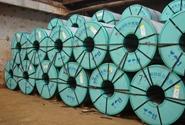Steel Products Prices North America

February 2017 Steel Imports
Written by Sandy Williams
March 28, 2017
The American Institute for International Steel reports steel imports in February were 21.3 percent higher than a year ago. AIIS cautions against U.S. protectionist policies that may hurt manufacturers who depend on global value supply chains. The press release from AIIS follows:
Falls Church, VA. March 27, 2017. Steel imports dipped 3.1 percent in February, giving back an equivalent gain in January to total 2.68 million net tons.
Imports were 21.3 percent higher than they were in February 2016.
Imports from the European Union and Japan declined by more than 21 percent each from January to February to 227,000 net tons and 139,000 net tons, respectively. This represented a 23.7 percent loss from a year earlier for the European Union and a 21.2 percent gain for Japan. Imports from South Korea fell 15.6 percent from December and nearly 30 percent from the previous February to 262,000 net tons, while imports from Canada slipped 8.1 percent from the preceding month to 488,000 net tons, which was 7 percent higher than a year earlier. Imports from Brazil, though, jumped 27.5 percent to 378,000 net tons, more than tripling the February 2016 total, and imports from Mexico increased 3.9 percent from December and almost 26 percent from February 2016 to 262,000 net tons.
Through the first two months of the year, imports were up 12.2 percent compared to 2016 at 5.45 million net tons. Canada shipped just over 1 million net tons of steel to the United States, a 7.9 percent increase, while Brazil shipped 674,000 net tons, almost one-third more than at this point last year. Imports from South Korea fell 7 percent year to date to 573,000 net tons, while imports from both Mexico and the European Union totaled 515,000 net tons, a 14.6 percent increase and a 19.3 percent decrease, respectively.
Semifinished imports increased almost five-fold from January to 641,000 net tons. The year-to-date total of 1.13 million net tons is more than double the January-February 2016 total.
Steel imports continue to face both economic and political headwinds. The Trump administration may be helping with the former – confidence in the economy has increased in recent months, which could translate into improved gross domestic product (GDP) growth – but it is exacerbating the latter. Imports provide quality steel at prices that are typically below what is paid on the domestic market. The administration is expected to focus on reforming the tax code during the next several months to make it more business friendly and promote economic expansion. This is laudable, but any economic growth that results from these policy reforms may be sharply curtailed or stymied altogether if the White House embraces protectionist trade policies and pursues unwarranted trade restrictions.
In an interim economic outlook it issued two weeks ago, the 35-member nation Organization for Economic Cooperation and Development (OECD) stated that rising protectionism is the biggest threat to near-term global economic growth. Pointing specifically to Europe, the United States, and China, the OECD warned that “A roll-back of existing trade openness would be costly…” The OECD further warned that countries with a significant share of jobs linked to participation in global value chains would see “a major adverse impact on trade and GDP.” As a major trade-dependent country whose economy has a significant share of jobs linked to participation in global value chains, particularly in steel and manufacturing, policymakers in the White House and on Capitol Hill should carefully consider the real threat of great harm posed by protectionist measures to the livelihoods of many tens of thousands of men and women who depend on these value and supply chains.

Sandy Williams
Read more from Sandy WilliamsLatest in Steel Products Prices North America

SMU Price Ranges: Sheet and plate steady ahead of Independence Day
Sheet and plate prices were little changed in the shortened week ahead of Independence Day, according to SMU’s latest check of the market.

Nucor maintains plate prices, opens August order book
Nucor aims to keep plate prices flat again with the opening of its August order book.

Nucor CSP remains level at $900/ton
Nucor maintained its weekly list price for hot-rolled (HR) coil this week, following two consecutive increases.

Cliffs raises prices, seeks $950/ton for July spot HR
Cleveland-Cliffs plans to increase prices for hot-rolled (HR) coil to $950 per short ton (st) with the opening of its July spot order book. The Cleveland-based steelmaker said the price hike was effective immediately in a letter to customers dated Monday.

HRC vs. prime scrap spread widens in June
The price spread between HRC and prime scrap widened in June.
